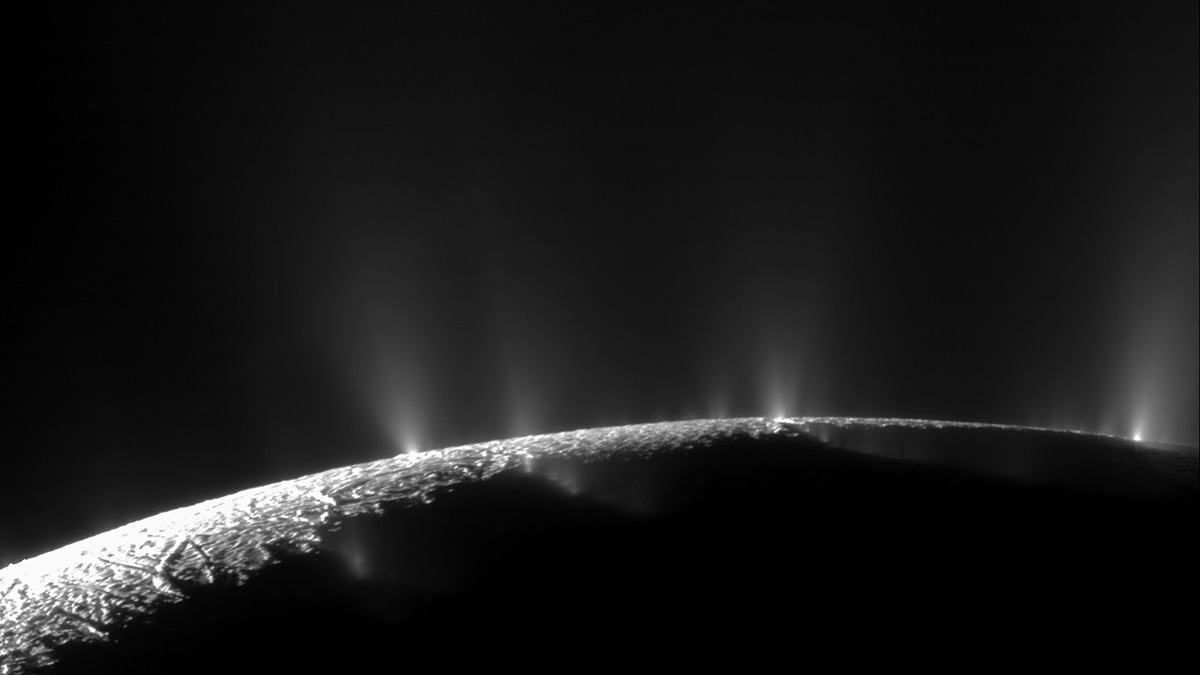When Cassini first buzzed by Saturn’s icy moon Enceladus in 2005, scientists were shocked to see columns of material blasting from cracks near the southern pole. The spacecraft discovered more than 100 small fountains jetting compounds, including water vapor and methane, directly into space. After discovering the jets, Cassini swooped through the material nine times, sampling its makeup despite the fact that none of the spacecraft’s instruments were designed to do so.
In the years since, scientists have tried to understand how the plumes’ geochemistry relates to its source—Enceladus’s vast, ice-capped ocean below. But although previous studies have sought to understand what the elusive ocean looks like today, one set of researchers sought to determine how those fountains altered the chemical composition of the Enceladean ocean over the 4.5-billion-year life of the solar system. They presented their findings at the Lunar and Planetary Science Conference (LPSC).
Mystery of the Missing Methane
Like many astronomers, Lucas Fifer and his colleagues began with the assumption that Enceladus and the rest of Saturn’s moons formed from the frigid fabric of the outer solar system, like comets. However, there is about 100 times less methane in the moon’s ocean today than would have been provided by comets. This is Enceladus’s “missing methane.”
“We tried to solve the mystery of the missing methane.”
“We tried to solve the mystery of the missing methane,” said Fifer, a graduate student at the University of Washington and presenter at LPSC. “We asked, Could it have been erupted away?”
The team gathered measurements of cometary abundances to approximate the original composition of Enceladus’s ocean as well as measurements of plume eruption rates and composition from Cassini data. In addition to water, the moon’s plumes vent gases, including methane, carbon dioxide, and ammonia, into space, and the team used that information to backtrack the current ocean composition to what it would have been millions or billions of years ago.
The modeling revealed a different problem: The plumes remove methane far more rapidly than they do carbon dioxide or ammonia. In the time it would have taken to go from original to modern quantities of the other two gases, a significant amount of methane would have been lost. While it’s possible that the original methane was mostly lost without replenishment if the plumes themselves were only a few hundred million years old, if the plumes are as old as the icy moon solar system, “some input of biological or hydrothermally generated methane is needed to compensate for loss via the plumes,” the researchers concluded.
Mystery of the Moon Itself
To Hunter Waite, a former Cassini team member who has studied the composition of the Enceladean plumes and ocean, it’s a bit too early to try to rewind the plumes. “This [plume material] is not necessarily pristine,” Waite cautioned. “We don’t exactly know what has happened to it, and so trying to figure out its origin from just what we know about Enceladus—this is a little bit scary.”
“I would sleep much better if we had another mission confirming the measurements of Cassini.”
Moreover, because Cassini wasn’t carrying instruments designed to collect samples, astronomers also have concerns about the accuracy of the samples it collected.
“I would sleep much better if we had another mission confirming the measurements of Cassini,” said Antonin Affholder, a postdoctoral researcher at the University of Arizona who was not involved in the new research.
Waite also questioned the built-in assumption that Enceladus formed from comet-like material in the first place. He said that the astronomical community is still debating how and when Saturn’s moons formed. Other explanations include the moons being born in the same collision that created the rings or forming alongside Saturn and the rest of the planets. Either one of those origins, Waite noted, would change the moon’s “expected starting abundance” of methane completely.
“It was pretty amazing for us to find a small icy moon out there that seems to be belching its ocean for us to sample.”
Fifer said the new model “is a first step and is at least showing that plume loss is something to be added to that list of important [geochemical] processes” in the Enceladean ocean.
Affholder, too, emphasized the importance of this aspect of the new research. “Constraining loss by ejection is important to further our understanding of Enceladus’ ocean geochemistry,” he said.
Ultimately, Waite said, “it was pretty amazing for us to find a small icy moon out there that seems to be belching its ocean for us to sample.…We need to go back with the right instrumentation and the right exploration process to sort out these questions because this is an absolutely fascinating object in the solar system.”
—Nola Taylor Tillman (@Nola_T_Tillman), Science Writer

